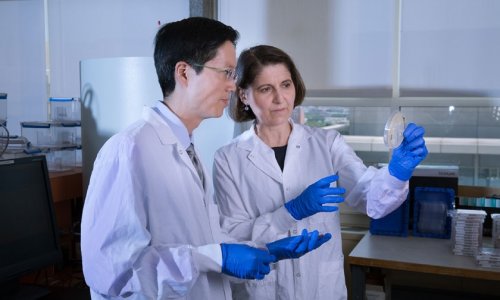Nosocomial infections
A call for greater hygiene expertise
As in so many European countries, nosocomial infections have hit the headlines in Germany over and over again in recent years – as when three premature babies died in a Bremen neonatal clinic in 2011.

Tragically, they were among the many: between 10,000 and 15,000 patients die of a hospital-acquired infections every year. In Germany the annual figure is 500,000 – and yet an estimated 1,500 to 4,500 of those deaths could be prevented by enhanced hospital hygiene measures, according to hygiene expert Professor Petra Gastmeier, Head of the Institute for Hygiene and Environmental Medicine at the Charité, University Medicine, Berlin and director of the German National Reference Centre for the Surveillance of Nosocomial Infections. ‘We anticipate that around a third of hospital acquired infections could be prevented,’ Prof. Gastmeier explained. ‘
The exogenous infections are particularly avoidable. However, endogenous infections are often inevitable. ‘Fortunately, the majority of nosocomial infections in Germany, around 42 percent, are harmless and easily treatable infections of the urinary tract. However, infections of the lower airways (around 21 percent), wound infections (about 16 percent) and sepsis (around eight percent) can be fatal, especially if the pathogens inducing the infection are multiresistant. Around 10 percent of all hospital germs are multi-resistant and therefore difficult to treat.
Which pathogens are they?
First, the Methicillin-resistant Staphylococcus aureus – MRSA – the incidence of MRSA is still stable. A national evaluation showed, that the rate of MRSA did not increase in between 2001 and 2009 and, compared to the other European countries, our rates are even a little lower than the European average. However, we are very concerned about the distinct increase of gram-negative bacteria, such as the extended-spectrum betalactamase- producing agents (ESBL).
Why is the incidence of ESBLproducing bacteria so alarming?
ESBL is an enzyme, breaking the molecular structure of most antibiotics, de-activating the molecule’s antibacterial properties and thus invalidating its therapeutic effect. By now germs have been identified that are even resistant to carbapenem antibiotics, the current reserve group for the treatment of ESBL-producing bacteria. We do not have any drug to combat these bacteria and there are no antibiotics in the pipeline. Therefore further hygiene steps are highly important to avoid the transmission of these germs. One of the most important means is the correct conduct of hand hygiene at the right time in the right place. The average hand hygiene compliance among German hospital staff is about 50 to 60 percent, in other words, every second hand-rub is left out.
Why? Partly, because there’s a lack of knowledge, for example, to know when hand hygiene is essential or how to hand-rub effectively. Some hospitals, or wards, still don’t attach sufficient significance to hand hygiene or hygiene is not even institutionalised. In some cases hand-rubs aren‘t even available where necessary. However, the main reason is the heavy workload, often linked with understaffing. Recently we published a study proving that the nurse to ventilated patient ratio has a significant impact on the nosocomial infection rate.
In 2008 the ‘Aktion saubere Hände’ (Clean Your Hands Campaign) was set up. The campaign offers a large scale of resources, information, educational material etc. and also monitors the compliance of hand hygiene and the consumption of alcohol hand-rub. How would you evaluate, as the director of one of the organising institutions, the effect of the campaign up to now?
Among the 152 hospitals voluntarily participating, we could evaluate an increase of hand-rub consumption of altogether 36 percent in three years, compared to the starting situation in 2007. That is a striking success and, because of this compelling result the Federal Ministry of Health promoted the campaign for a further three years. Up to 2013, we will broaden the focus of the campaign on care facilities and out-patient care.
What could be done to enhance hospital hygiene further?
We definitely should invest more in education! In the last decade, plenty of Chairs in hygiene have been reduced in Germany – leaving only six in 2011. I therefore appreciate the implementation of crash training courses in hygiene for internists, intensive care specialists, surgeons etc., because of the requirements of the revised German Infection Protection Act of 2011, to rapidly correct the shortage of hygienists in Germany’s hospitals.
Interview: Bettina Döbereiner
14.01.2013





